Did you know that pairing certain plants can naturally ward off garden pests? Try companion planting by placing marigolds near your tomatoes to repel aphids and nematodes. It’s a simple trick, but you’ll need to space them about 12 inches apart for the best effect. Curious how other natural methods, like neem oil, can boost your garden’s defenses? Stick around to uncover more practical tips for a thriving, pest-free yard.
Contents
Companion Planting

While you might think pest control means spraying chemicals, let’s explore a natural trick called companion planting. It’s a clever method, and you’ve got this!
Basically, you plant certain crops together to fend off bugs. For instance, pair basil with tomatoes to boost growth and repel flies; just tuck basil seedlings 12 inches apart around your tomato plants.
Now, let’s get specific with timing and spacing. Start planting in early spring, ensuring a 2-foot gap between rows for airflow, which discourages pests. Check weekly for unwanted critters, and adjust as needed.
Here’s the deal—mixing plants like beans with corn can maximize space and support. Try it out in a 4×4-foot plot, and watch nature work its quiet magic!
Marigold Pest Deterrence
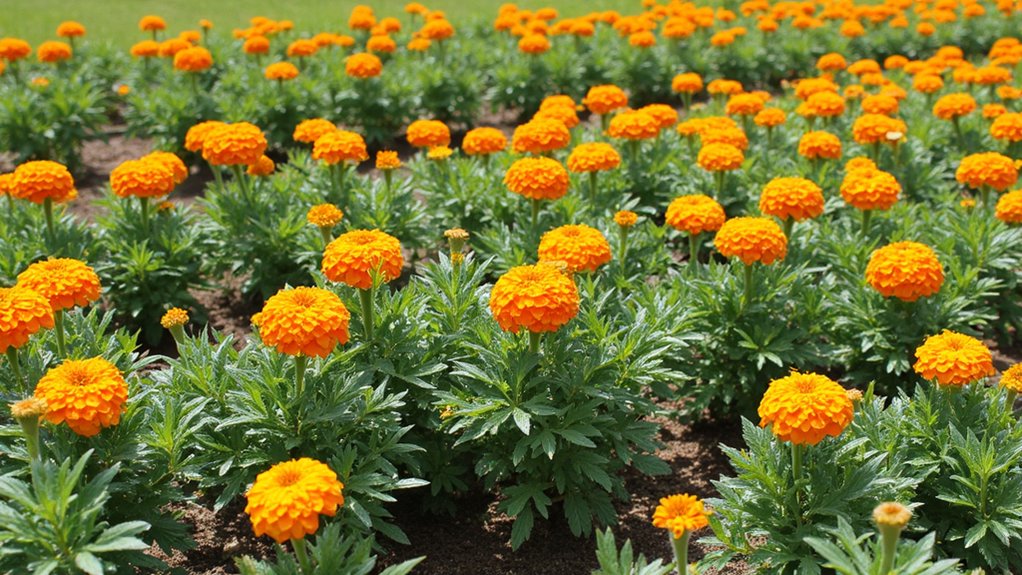
As you immerse yourself in natural pest control, let’s talk about marigolds, a powerhouse for keeping bugs at bay. These vibrant flowers aren’t just pretty; they repel pests like nematodes, aphids, and whiteflies with their strong scent. Plant them strategically, and you’ll see results.
Start by placing marigolds around your garden’s perimeter, spacing them about 12 inches apart for full coverage. Their roots release a chemical, alpha-terthienyl, which deters soil-dwelling pests. Interplant them near tomatoes or beans, too, for added protection.
Make sure you sow seeds in early spring, after the last frost, in well-drained soil with full sun. Water them moderately, about 1 inch per week, to keep them thriving. With this setup, you’re building a natural pest barrier effortlessly.
Neem Oil Application

Let’s explore neem oil, a fantastic natural solution for tackling garden pests. You’ve probably got bugs munching on your plants, right? Well, neem oil, derived from the neem tree, disrupts pests’ life cycles without harsh chemicals.
Start by mixing 2 teaspoons of neem oil with 1 teaspoon of mild liquid soap in a quart of water. Shake it well in a spray bottle, ensuring it’s fully combined. Spray this mix on your plants every 7-14 days, focusing on the undersides of leaves where pests hide. Do this early morning or late evening to avoid leaf burn from the sun.
Always test a small area first, as some plants might react poorly. Store leftover solution in a cool, dark place for later use.
Garlic Spray Protection
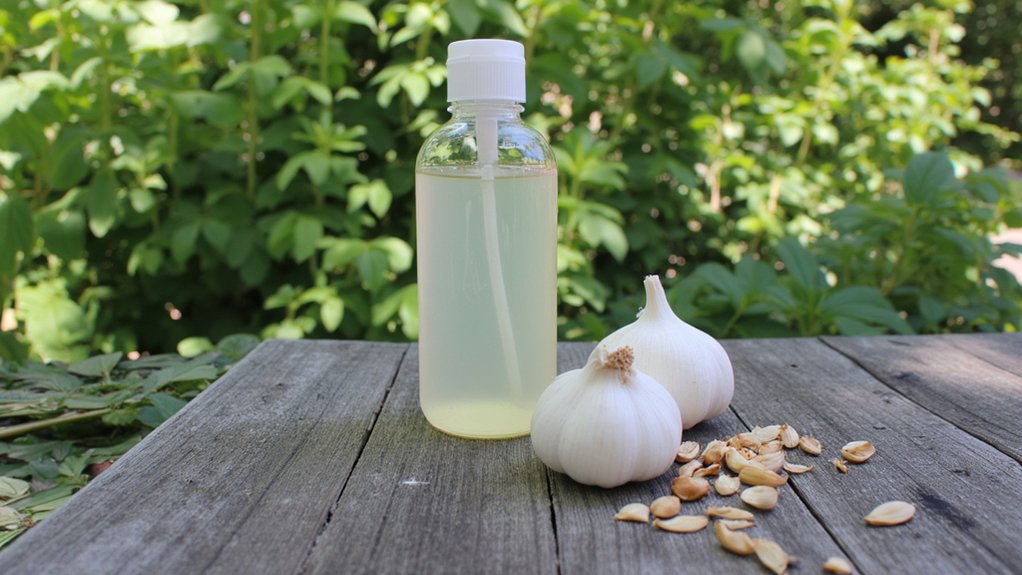
Moving on from neem oil, garlic spray offers another powerful way to shield your garden from pests. You’ve probably got garlic in your kitchen, so let’s turn it into a pest deterrent. It’s simple, effective, and safe for most plants.
Start by crushing 5-6 garlic cloves, then mix them with a quart of water in a jar. Let it steep for 24 hours, strain the liquid, and add a teaspoon of dish soap to help it stick. Pour this into a spray bottle, and you’re ready to go.
Apply it to your plants’ leaves, especially under them, every 3-4 days or after rain. Pests like aphids and beetles hate the smell, so they’ll steer clear. Keep reapplying for consistent protection.
Diatomaceous Earth Application
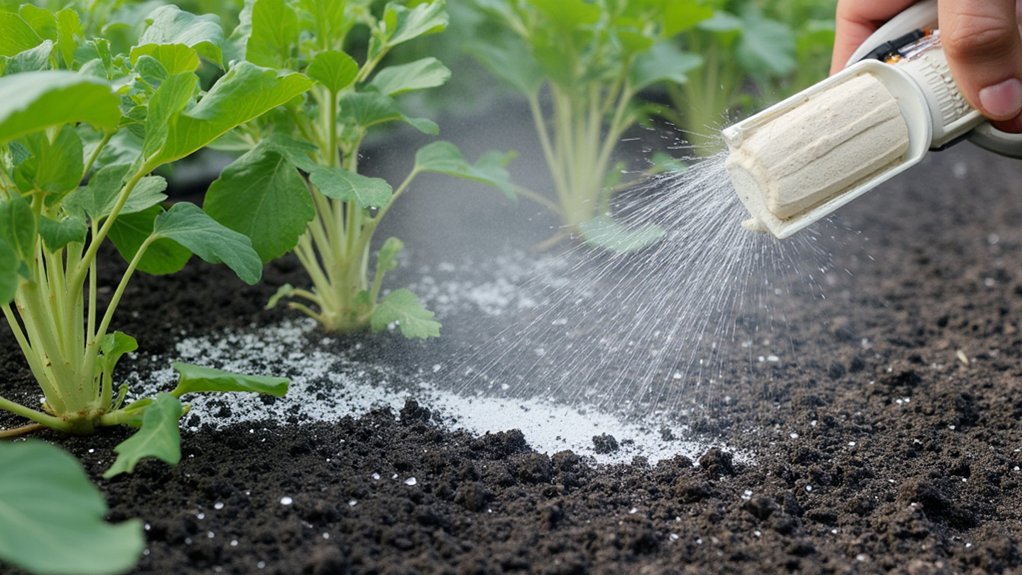
Ever considered a natural powder to fend off garden pests? Well, diatomaceous earth, or DE, might be your new best friend. It’s a fine, powdery substance made from fossilized algae, and it’s deadly to bugs.
Sprinkle food-grade DE around your garden beds, focusing on areas with pest activity. Use about 1-2 tablespoons per square foot, applying it with a duster or shaker for even coverage. Reapply every 7-10 days, especially after rain, since moisture reduces its effectiveness.
Wear a mask while handling it, though, as the dust can irritate your lungs. Target pests like slugs, ants, and beetles by dusting directly on plants or soil. Check progress after a few days, and adjust application if needed. It’s simple, natural, and works!
Soap Spray Solution
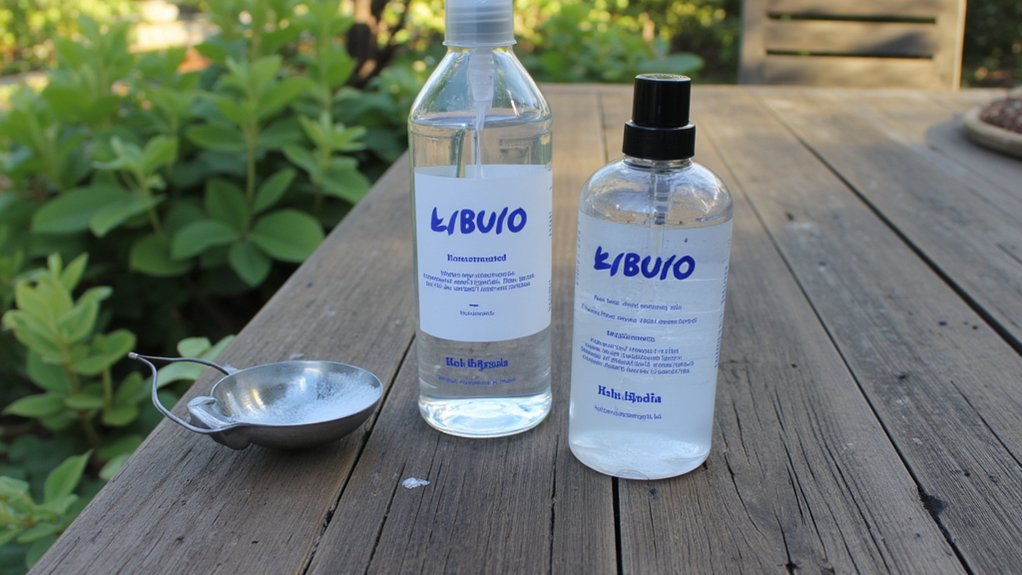
Want another easy, natural way to tackle garden pests after trying diatomaceous earth? Let’s whip up a soap spray solution, a simple fix for pesky bugs. You’ll need just a few household items to get started.
Mix one tablespoon of liquid dish soap, preferably unscented, with a gallon of water. Stir it gently in a bucket or jug, ensuring it’s well combined. Don’t use too much soap, or you’ll risk harming your plants.
Grab a spray bottle, fill it with your mixture, and head to your garden. Spray directly on affected leaves, especially under them, where pests hide. Do this early in the morning or late evening to avoid sunburn on wet leaves. Reapply every few days, if needed, until bugs disappear.
Beneficial Insect Attraction
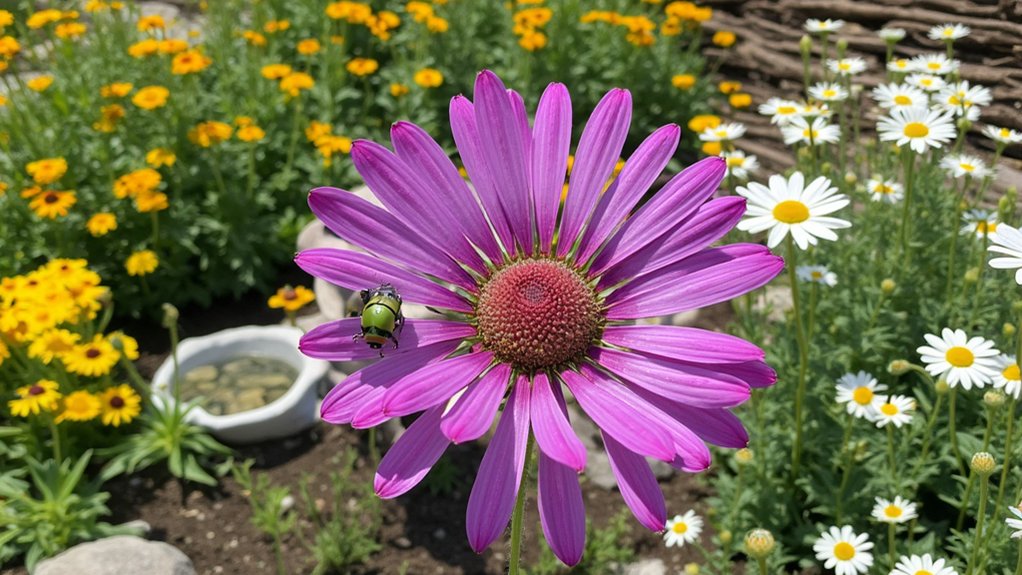
If you’re looking for a hands-off way to manage garden pests, consider attracting beneficial insects to do the dirty work. These little helpers, like ladybugs and lacewings, eat aphids, mites, and other nuisances. You’ve got nature’s pest control right at your fingertips!
Start by planting nectar-rich flowers, such as marigolds or yarrow, near your veggies. Aim for a 3-foot radius around key crops, and plant them early in spring. This draws beneficial bugs in fast.
Next, avoid harsh chemicals; they’ll kill the good guys, too. Instead, provide shallow water dishes with pebbles for insects to drink safely. Check weekly to refill them. Finally, add small shelters, like twig piles, for nesting. It’s simple, effective pest management!
Vinegar Pest Repellent
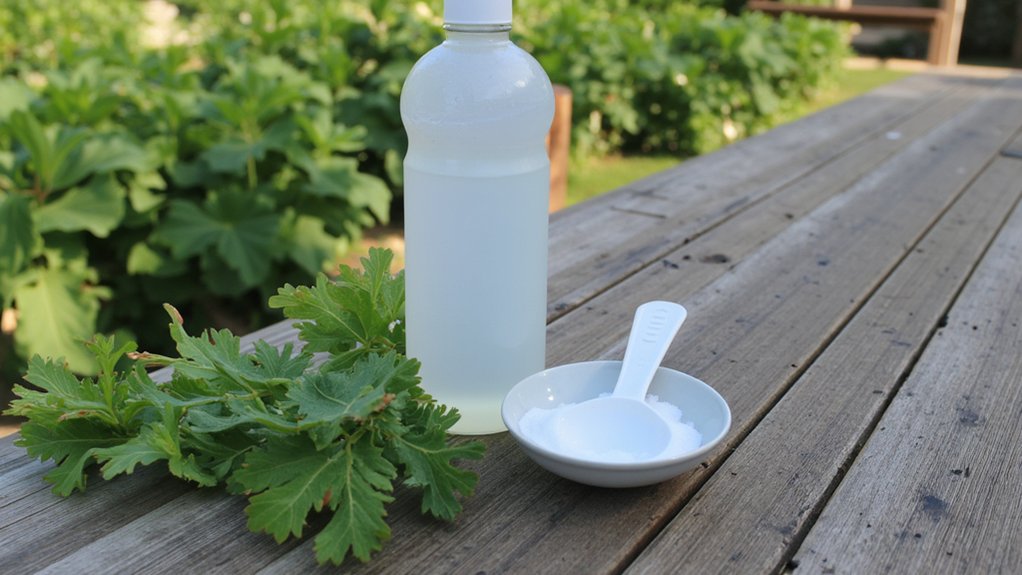
Try using vinegar as another handy trick to keep pests at bay in your garden. It’s cheap, easy, and works surprisingly well against many critters. Mix equal parts water and white vinegar, about a cup each, in a spray bottle. Shake it up, then you’re ready to go.
Spray this solution directly on areas where pests like ants or aphids hang out. Focus on plant stems, leaves, and soil near the base, but don’t drench the plants. Apply it every few days, especially after rain, to maintain its effect. You’ll notice fewer bugs nibbling at your greens.
Keep the bottle handy for quick touch-ups. Test a small area first, though, as some plants might not tolerate vinegar well. Stick with it, and watch those pests scatter!
Essential Oil Repellents
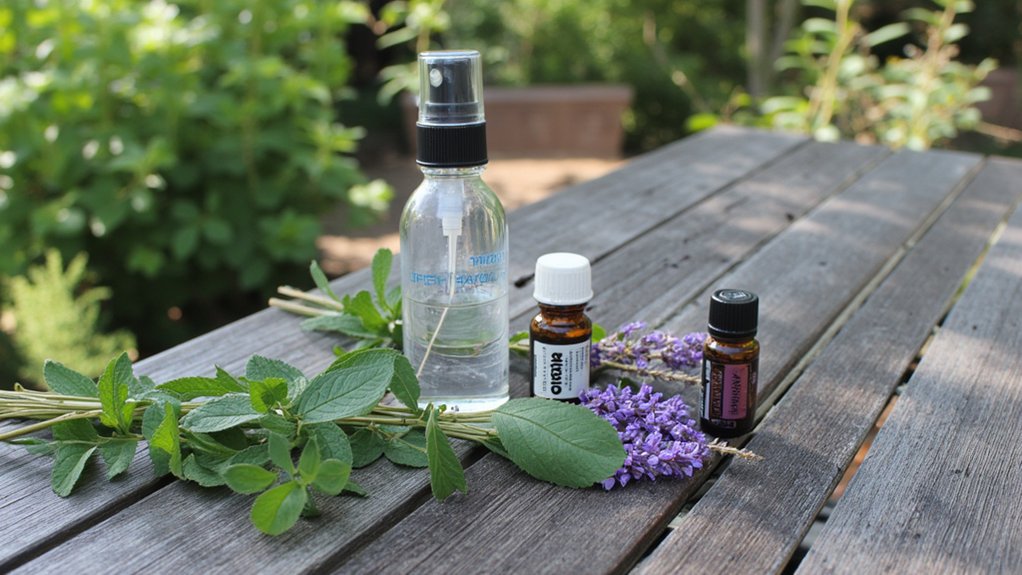
While vinegar works wonders, let’s explore another natural option with essential oil repellents. You’ve likely got some oils at home, so let’s put ‘em to work! Essential oils like peppermint, lavender, and tea tree can deter pests effectively.
Start by mixing 10-15 drops of peppermint oil with a cup of water in a spray bottle. Shake it well, then spritz around your garden beds, focusing on entry points. Reapply every 3-4 days, or after rain, to keep bugs at bay.
These oils mess with pests’ senses, driving ‘em away without harmful chemicals. Test a small area first, though, to verify your plants don’t react badly. Stick with this, and you’ll see fewer creepy crawlies munching your greens!
Baking Soda Fungicide
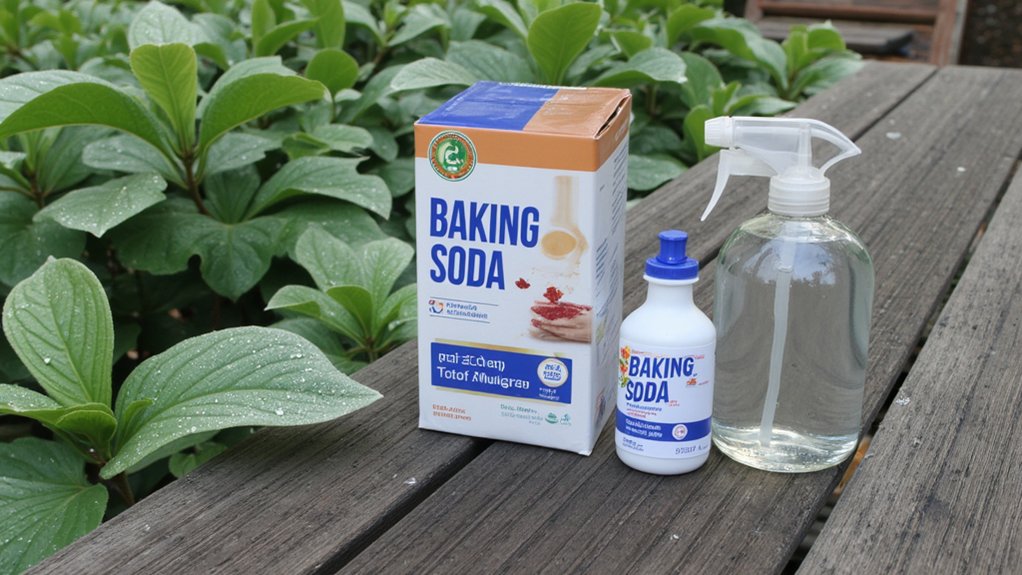
Take a look at another handy trick with baking soda fungicide, a simple fix for plant issues. You’ve probably got baking soda in your kitchen, so let’s put it to work. It’s great for tackling fungal problems like powdery mildew on your plants.
Mix 1 tablespoon of baking soda with 1 gallon of water, then add a few drops of dish soap. Shake it up in a spray bottle, and you’re ready to go. Spray this mix on affected leaves every 7-10 days, ideally in the early morning.
Make sure you cover both sides of the leaves, top and bottom, for best results. Don’t overdo it, though; too much can harm your plants. Stick to this schedule, and watch those fungi disappear!
